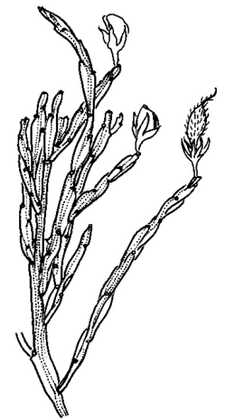Common name: Winged Broom-pea, Dogwood
Jacksonia scoparia R.Br. APNI* 
Description: Shrub or small tree up to 12 m high; branches and branchlets erect or pendulous, strongly angled or winged, ± minutely pubescent.
Leaves usually reduced to scales, occasionally a few leaves present at base of branches or on young plants, obovate, petiolate.
Flowers few in terminal racemes and in upper axils; pedicels 3–5 mm long. Calyx 5–8 mm long, silky-pubescent, teeth oblong-lanceolate, ± equal. Corolla 5–10 mm long, cream to orange-yellow.
Pod oblong-elliptic, 6–12 mm long, hairy, stipe 3–4 mm long.
Flowering: spring to early summer.
Distribution and occurrence: Widespread on low-nutrient gravelly soils associated with shales or clay, on hillsides and ridges; north from the Bega district.
NSW subdivisions: NC, CC, SC, NT, CT, ST, NWS, CWS, NWP, SWP
Other Australian states: Qld
This is a variable species. A form growing on headlands has been known as the 'headland form' or has been separated as J. scoparia var. gonoclada Maiden & Betche; it differs in that the branchlets are densely divided and winged (wings 1-2 mm wide), and grey from a minute pubescence (north from the Shoalhaven R.; NC, CC, SC, Qld)
Text by B. Wiecek
Taxon concept: Flora of NSW 2 (1991)
APNI* Provides a link to the Australian Plant Name Index (hosted by the Australian National Botanic Gardens) for comprehensive bibliographic data
***The AVH map option provides a detailed interactive Australia wide distribution map drawn from collections held by all major Australian herbaria participating in the Australian Virtual Herbarium project.
|


